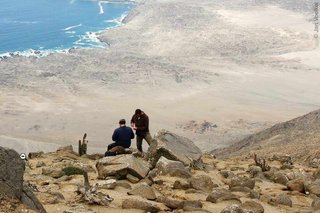For the first time, the Amazon basin could be identified as dominant source region for water precipitating in the Atacama Desert in northern Chile. From the rainforest, elevated water vapour travels more than 2000 km westwards, crosses the Andes, and turns southeast over the Pacific to form precipitation over the Atacama Desert. Dr Christoph Böhm from the University of Cologne’s Institute of Geophysics and Meteorology has identified moisture conveyor belts (MCBs) as the main mechanism for precipitation. They account for 40 to 80 per cent of total precipitation in the Atacama. The findings show a new pathway of water supply for one of the driest regions on Earth aside from summer rain due to moist easterly winds (Bolivian High) and winter rain associated with westerly storm tracks. The study has been published in Geophysical Research Letters.
Aside from the poles, the Atacama Desert is the driest region on Earth with annual precipitation rates below 2 l/m² (for comparison, the city of Cologne in Germany receives around 800 l/m² during an average year). Previously, two different mechanisms have been described for the Atacama Desert: During the summer, episodic moist easterly winds transfer storm systems across the Andean mountain range, which usually impedes a transfer of moist air from the interior continent. Associated precipitation affects mainly the northeastern part of the Atacama with decreasing rates towards the lower lying dry core of the desert. During winter, low pressure systems, which we are used to in more temperate midlatitude regions, can reach even subtropical regions and cause cloudiness and rain. These systems affect mainly the southwestern Atacama and have their origins over the Pacific Ocean.
Now, a third mechanism could be discovered which results in extreme precipitation events, Christoph Böhm explained: ‘Accounting for more than half of the total precipitation in the Atacama Desert, moisture conveyor belts were established as the main precipitation source. These are special weather phenomena which feature strong water vapour transport.’ Along the filamentary structure (mostly in heights between 3000 to 6000 m above sea level), water is transported across long distances without much exchange with the underlying moist Pacific air along the journey. When the water vapour band, which originated in the Amazon basin, reaches the Atacama Desert from the northwest, the air flow has to cross the coastal mountain range towering up to 2500 m. The air is forced to rise, which leads to cooling and, in turn, to precipitation formation.
‘The heavier the precipitation event, the more likely it is associated with such a moisture conveyor belt,’ said Böhm. ‘For a specific case, a region in the driest part of the desert received more than 50 l/m² rain, which exceeded the tenfold annual average. For highly adapted species, the sudden water availability can bring death.’ At the same time, such events trigger biological explosions like the spectacular flowering desert. Furthermore, run-off generated by heavy rainfall is capable of moving debris and reshaping the landscape. Traces from such activities like pollen and organic carbon deposition or moved material of different grain sizes are manifested in the desert soil and conserved through the enduring dryness.
‘Researchers exploit geological archives like such soil samples to reconstruct climate history. Now we know that potential hints for phases of more frequent heavy rain events have to be interpreted in the new light of moisture conveyor belts, which most likely dominate the precipitation signal seen in these geological archives,’ explained Böhm. Additionally, scientists can extract information on humidity in past geological eras from different isotopes of water atoms from the desert soil. The ratio of heavier, more neutron-containing, to lighter water isotopes reflects atmospheric water supply. In particular, in the Atacama Desert the gypsum soil conserves the water isotopic composition from when it was formed millions of years ago. ‘To paint a consistent picture, the source and pathway of the supplied water has to be considered, as it determines the fractionation processes of the water isotopes. The new results help to constrain assumptions necessary for such investigation and will allow more conclusive results.’
Situations of enhanced water vapour or even precipitation also affect astronomers’ research, as the Atacama hosts many world leading astronomical observatories. Atmospheric water vapour perturbs a clear view of space. ‘The improved understanding of the mechanisms behind water vapour transport will enable better predictions of suitable conditions for these challenging observations in the context of a changing climate,’ Böhm concluded.
Contact:
Dr. Christoph Böhm
Institute for Geophysics and Meteorology
University of Cologne
+49 221 470 6112
c.boehmuni-koeln.de
Press and Communication:
Robert Hahn
+49 221 470 2396
r.hahnverw.uni-koeln.de
Link:
